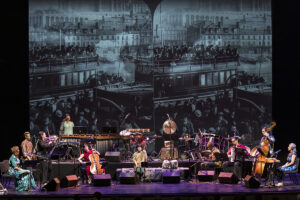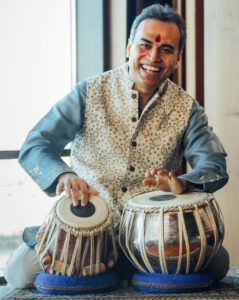Global Music at the Schermerhorn
American Railroads from the Silkroad Ensemble
The Grammy Award-winning music ensemble, Silkroad Ensemble, performed the American Railroad concert at the Schermerhorn this past Sunday, November 10th. Rhiannon Giddens, Artistic Director of Silkroad

Ensemble, showcased underrepresented minority groups who contributed significantly to constructing the railroads in America. Throughout all pieces, they included images of immigrant workers on the projector screen to acknowledge and honor these laborers.
At the beginning of the concert, they played a video describing the history behind the American Railroad. These groups included African Americans, Chinese, Japanese, and other immigrant laborers who were represented through their music. When the ensemble members walked on stage, they wore very beautiful, colored outfits, illuminating their music-making. The first piece started with a horn call made by Pura Fé through what looked like a conch shell. This later led to the next piece called, “Tamping Song” which featured Yazhi Guo on suona, a traditional Chinese double-reed instrument, and other string instruments like cello and violins. This piece began with the plucking of strings rotating among each string instrument, creating an echo throughout the auditorium, and then was joined with melodic chanting. The suona would later solo on this piece and create a loud but controlled reedy sound, marking its dominance. It was a great start to the program because it introduced the ensemble’s sound through the varying instruments on stage.
The third piece on the program was about the Swannanoa Tunnel. African American laborers were the main groups that worked on this tunnel and worked under very

harsh conditions. This piece was in English, which differed from the previous two. Rhiannon has such a warm and full tone when she sings, and her voice brings much emotion as she describes the workers’ conditions in the song. Her singing was accompanied by Kaoru Watanabe, who was striking each beat on the drums, sounding like a funeral march. This made the piece much more powerful and emotional. When she reached the end of the song, she entered into a fiddling session, shifting the style of this piece. The mood is much lighter and uplifting than how it started, which gives the piece an interesting contrast.
The fifth piece on the program involved various percussion instruments. Shane Shanahan performed on frame drums, Sandeep Das on tabla, and Francesco Turrisi featured on the accordion. Shane started the piece by playing the jaw harp with Sandeep’s tabla playing but later switched to frame drums when Sandeep began his quick hand drumming solo. Then there would be a call and response between that and the accordion. Sandeep would later vocalize some of the rhythms near the middle of the piece. Each performer would try to match the rhythms of what he vocalized onto their instruments, which was very entertaining because the rhythms kept getting faster and more complex. They ultimately synchronized the instruments with the same rhythms that Sandeep chanted. This performance truly demonstrated great virtuosity among all performers.

One of the pieces near the end of the concert was about the wives of Chinese railroad workers and how they miss their husbands. Rhiannon sang a Chinese folk song with her banjo, a hulusi, and an accordion. This arrangement was created for banjo and pipa, a plucked lute. The hulusi performer, Yazhi Guo, and accordionist, Francesco, acted as the pipa in this song creating a conversation between the instruments. It was beautiful to listen to, and Rhiannon did a fantastic job with how she drew upon each note, lengthening it to create this hefty feel. After that piece, Pura sang a song called, “Mahk Jchi,” also known as the “Heartbeat Drum Song,” a Native American song she wrote. She used a lap-steel guitar to start this song off. Her voice brought so much emotion and power by filling the space with crescendos throughout the phrases as the song progressed. She then sang the latter half of the song and ended it in a Tutelo-Saponi dialect.
The ensemble finished the concert with an encore that led Rhiannon to turn the stage into a very fun fiddling session. The musicians were introduced through their improvised solos, creating an opportunity to see them jam out on their primary instruments. It was especially interesting to see Maeve Gilchrist improv on her Celtic harp because she could perform non-Western techniques on it, which I had not heard of before. This all led to a well-deserved standing ovation from the audience for the incredible work that have put into this program.
This performance was spectacular and very fun with audience members clapping along and dancing in their seats. It is an ensemble full of virtuosos and incredibly passionate musicians who desire to bridge the gap between cultures. I very much admire their work and I had such a great time listening to the performances. Be sure to check them out and be on the lookout for future Silkroad Ensemble concerts.



